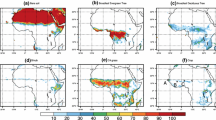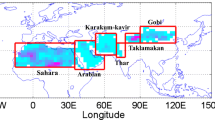Abstract
The importance of specifying realistic lateral boundary conditions in the regional modeling of mineral aerosols has not been examined previously. This study examines the impact of assigning values for mineral aerosol (dust) concentrations at the lateral boundaries of Regional Climate Model version 3 (RegCM3) and its aerosol model over Southwest Asia. Currently, the dust emission module of RegCM3 operates over the interior of the domain, allowing dust to be transported to the boundaries, but neglecting any dust emitted at these points or from outside the domain. To account for possible dust occurring at, or entering from the boundaries, mixing ratios of dust concentrations from a larger domain RegCM3 simulation are specified at the boundaries of a smaller domain over Southwest Asia. The lateral boundary conditions are monthly averaged concentration values (μg of dust per kg of dry air) resolved in the vertical for all four dust bin sizes within RegCM3’s aerosol model. RegCM3 simulations with the aerosol/dust model including lateral boundary conditions for dust are performed for a five year period and compared to model simulations without prescribed dust concentrations at the boundaries. Results indicate that specifying boundary conditions has a significant impact on dust loading across the entire domain over Southwest Asia. More specifically, a nearly 30% increase in aerosol optical depth occurs during the summer months from specifying realistic dust boundary conditions, bringing model results closer to observations such as MISR. In addition, smaller dust particles at the boundaries have a more important impact than large particles in affecting the dust loading within the interior of this domain. Moreover, increases in aerosol optical depth and dust concentrations within the interior domain are not entirely caused by inflow from the boundaries; results indicate that an increase in the gradient of concentration at the boundaries causes an increase of diffusion from the boundaries. Lastly, experiments performed using a climatology of dust concentrations yield similar results to those using actual monthly values. Therefore, using a climatology of dust mixing ratios is sufficient in implementing lateral boundary conditions for mineral aerosols. In short, this work concludes that realistic specification of lateral boundary conditions for mineral aerosols can be important in modeling the dust loading over arid regional climates such as Southwest Asia.









Similar content being viewed by others
References
Abdou WA, Diner DA, Martonchik JV, Bruegge CJ, Kahn RA, Gaitley BJ, Crean KA, Remer LA, Holben B (2005) Comparison of coincident multiangle imaging spectroradiometer and moderate resolution imaging spectroradiometer aerosol optical depths over land and ocean scenes containing aerosol robotic network sites. J Geophys Res 110:D10S07
Alfaro S, Gomes L (2001) Modelling mineral aerosol production by wind erosion: emission intensities and aerosol size distributions in source areas. J Geophys Res 106:18075–18084
Cakmur RV, Miller RL, Torres O (2004) Incorporating the effect of small-scale circulations upon dust emission in an atmospheric general circulation model. J Geophys Res 109:D07201
Davies H, Turner R (1977) Updating prediction models by dynamical relaxation: an examination of the technique. Quar J Am Meteorol Soc 103:225–245
Dickinson R, Henderson-Sellers A, Kennedy P (1993) Biosphere atmosphere transfer scheme (BATS) version 1e as coupled to the NCAR Community Climate Model. Technical report, National Center for Atmospheric Research
Giorgi F, Marinucci M, Bates G (1993) Development of a second generation regional climate model (regcm2). Part I: boundary layer and radiative transfer processes. Mon Weather Rev 121:2794–2813
Giorgi F, Marinucci M, Bates G, DeCanio G (1993) Development of a second generation regional climate model (regcm2). Part II: convective processes and assimilation of lateral boundary conditions. Mon Weather Rev 121:2814–2832
Giorgi F, Mearns L, Shields C, McDaniel L (1998) Regional nested model simulations of present day and 2xco2 climate over the Central Plains of the US. Clim Change 40:457–493
Grell G, Dudhia JJ, Stauffer D (1994) A description of the fifth-generation Penn State/NCAR Mesoscale Model (MM5), Technical Note TN-398+IA
Holtslag A, de Bruin E, Pan H (1990) A high resolution air mass transformation model for short-range weather forecasting. Mon Weather Rev 118:1561–1575
Kahn RA, Nelson D, Garay M, Levy R, Bull M, Diner D, Martonchik J, Paradise S, Hansen E, Remer L (2009) Misr aerosol product attributes and statistical comparisons with modis. Geosci Remote Sens 47:4095–4114
Kalnay E, Kanamitsu M, Kistler R, Collins W, Deaven D, Gandin L, Iredell M, Saha S, White G, Woollen J, Zhu Y, Leetmaa A, Reynolds B, Chelliah M, Ebisuzaki W, Higgins W, Janowiak J, Mo K, Ropelewski C, Wang J, Jenne R, Joseph D (1996) The NCEP/NCAR 40-year reanalysis project. Bull Am Meteorol Soc 77:437–471
Kiehl J, Hack J, Bonan G, Boville B, Breigleb B, Williamson D, Rasch PJ (1996) Description of the ncar community climate model (ccm3). Technical Note TN-420+STR, National Center for Atmospheric Research
Luo C, Mahowald N, del Corral J (2003) Sensitivity study of meteorological parameters on mineral aerosol mobilization, transport, and distribution. J Geophys Res 108:4447
Marcella MP, Eltahir EAB (2008) Modeling the hydroclimatology of Kuwait: the role of subcloud evaporation in semiarid climates. J Clim 21:2976–2989
Marcella MP, Eltahir EAB (2010) Effects of mineral aerosols on the summertime climate of southwest asia: Incorporating subgrid variability in a dust emission scheme. J Geophys Res D18203. doi:10.1029/2010DOI14036
Marticorena B, Bergametti G (1995) Modeling the atmospheric dust cycle, i, design of soil-derived dust emission scheme. J Geophys Res 100:16416–16430
Miller R, Tegen I (1998) Climate response to soil dust aerosols. J Clim 11:3247–3267
Pal J, Giorgi F, Bi X, Elguindi N, Solmon F, Gao X, Francisco A, andd Zakey R, Winter J, Ashfaq M, Syed F, Bell J, Diffenbaugh N, Karmacharya J, Konare A, Martinez-Castro D, Porfirioda Rocha R, Sloan L, Steiner A (2007) Regional climate modeling for the developing world: the ICTP RegCNET and RegCM. Bull Am Meteorol Soc 88:1395–1409
Pal J, Small E, Eltahir EAB (2000) Simulation of regional-scale water and energy budgets: representation of subgrid cloud and precipitation processes within RegCM. J Geophys Res 105:29579–29594
Prasad AK, Singh RP (2006) Comparison of misr-modi aerosol optical depth over the indo-gangetic basin during the winter and summer seasons (200-2005). Remote Sens Environ 107:109–119
Prospero JM, Ginoux P, Torres O, Nicholson E, Gill TE (2002) Environmental characterization of global sources of atmospheric soil dust identified with the Nimbus 7 total ozone mapping spectrometer (TOMS) absorbing aerosol product. Rev Geophys 40:1–29
Reynolds RW (2002) An improved in situ and satellite SST analysis for climate. J Clim 15:1609–1625
Sokolik IN, Winker DM, Bergametti G, Gillette DA, Carmichael G, Kaufman YJ, Gomes L, Schuetz L, Penner JE (2001) Introduction to special section: outstanding problems in quantifying the radiative impacts of mineral dust. J Geophys Res 106:18015–18027
Solmon F, Mallet M, Elguindi N, Giorgi F, Zakey AS, Konare A (2008) Dust aerosol impact on regional precipitation over western Africa, mechanisms and sensitivity to absorption properties. Geophys Res Lett 35:L24705
Tegen I, Lacis AA (1996) Modeling of particle size distribution and its influence on the radiative properties of mineral dust aerosols. J Geophys Res 101:19237–19244
Tegen I, Miller RL (1998) A general circulation model study on the interannual variability of soil dust aerosol. J Geophys Res 103:25875–25995
Zakey A, Solmon F, Giorgi F (2006) Implementation and testing of a desert dust module in a regional implementation and testing of a desert dust module in a regional climate model. Atmos Chem Phys 6:4687–4704
Zeng X, Zhao M, Dickinson R (1998) Intercomparison of bulk aerodynamic algorithms for the computation of sea surface fluxes using TOGA coare and TAO data. J Clim 11:2628–2644
Zhang DF, Zakey AS, Gao XJ, Giorgi F, Solmon F (2009) Simulation of dust aerosol and its regional feedbacks over east asia using a regional climate model. Atmos Chem Phys 9:1095–1110
Acknowledgments
The authors are grateful to all members of the Eltahir group and M.I.T. Parsons Laboratory that contributed in some way to this work. This work has been funded through support by the Kuwait Foundation for the Advancement of Science.
Author information
Authors and Affiliations
Corresponding author
Rights and permissions
About this article
Cite this article
Marcella, M.P., Eltahir, E.A.B. The role of lateral boundary conditions in simulations of mineral aerosols by a regional climate model of Southwest Asia. Clim Dyn 38, 109–120 (2012). https://doi.org/10.1007/s00382-010-0992-y
Received:
Accepted:
Published:
Issue Date:
DOI: https://doi.org/10.1007/s00382-010-0992-y




